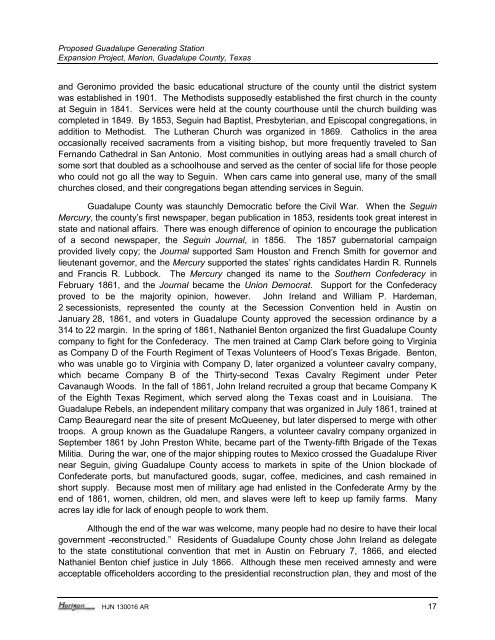Guadalupe Generating Station Final Cultural Resourse Report - US ...
Guadalupe Generating Station Final Cultural Resourse Report - US ...
Guadalupe Generating Station Final Cultural Resourse Report - US ...
You also want an ePaper? Increase the reach of your titles
YUMPU automatically turns print PDFs into web optimized ePapers that Google loves.
Proposed <strong>Guadalupe</strong> <strong>Generating</strong> <strong>Station</strong><br />
Expansion Project, Marion, <strong>Guadalupe</strong> County, Texas<br />
and Geronimo provided the basic educational structure of the county until the district system<br />
was established in 1901. The Methodists supposedly established the first church in the county<br />
at Seguin in 1841. Services were held at the county courthouse until the church building was<br />
completed in 1849. By 1853, Seguin had Baptist, Presbyterian, and Episcopal congregations, in<br />
addition to Methodist. The Lutheran Church was organized in 1869. Catholics in the area<br />
occasionally received sacraments from a visiting bishop, but more frequently traveled to San<br />
Fernando Cathedral in San Antonio. Most communities in outlying areas had a small church of<br />
some sort that doubled as a schoolhouse and served as the center of social life for those people<br />
who could not go all the way to Seguin. When cars came into general use, many of the small<br />
churches closed, and their congregations began attending services in Seguin.<br />
<strong>Guadalupe</strong> County was staunchly Democratic before the Civil War. When the Seguin<br />
Mercury, the county’s first newspaper, began publication in 1853, residents took great interest in<br />
state and national affairs. There was enough difference of opinion to encourage the publication<br />
of a second newspaper, the Seguin Journal, in 1856. The 1857 gubernatorial campaign<br />
provided lively copy; the Journal supported Sam Houston and French Smith for governor and<br />
lieutenant governor, and the Mercury supported the states’ rights candidates Hardin R. Runnels<br />
and Francis R. Lubbock. The Mercury changed its name to the Southern Confederacy in<br />
February 1861, and the Journal became the Union Democrat. Support for the Confederacy<br />
proved to be the majority opinion, however. John Ireland and William P. Hardeman,<br />
2 secessionists, represented the county at the Secession Convention held in Austin on<br />
January 28, 1861, and voters in <strong>Guadalupe</strong> County approved the secession ordinance by a<br />
314 to 22 margin. In the spring of 1861, Nathaniel Benton organized the first <strong>Guadalupe</strong> County<br />
company to fight for the Confederacy. The men trained at Camp Clark before going to Virginia<br />
as Company D of the Fourth Regiment of Texas Volunteers of Hood’s Texas Brigade. Benton,<br />
who was unable go to Virginia with Company D, later organized a volunteer cavalry company,<br />
which became Company B of the Thirty-second Texas Cavalry Regiment under Peter<br />
Cavanaugh Woods. In the fall of 1861, John Ireland recruited a group that became Company K<br />
of the Eighth Texas Regiment, which served along the Texas coast and in Louisiana. The<br />
<strong>Guadalupe</strong> Rebels, an independent military company that was organized in July 1861, trained at<br />
Camp Beauregard near the site of present McQueeney, but later dispersed to merge with other<br />
troops. A group known as the <strong>Guadalupe</strong> Rangers, a volunteer cavalry company organized in<br />
September 1861 by John Preston White, became part of the Twenty-fifth Brigade of the Texas<br />
Militia. During the war, one of the major shipping routes to Mexico crossed the <strong>Guadalupe</strong> River<br />
near Seguin, giving <strong>Guadalupe</strong> County access to markets in spite of the Union blockade of<br />
Confederate ports, but manufactured goods, sugar, coffee, medicines, and cash remained in<br />
short supply. Because most men of military age had enlisted in the Confederate Army by the<br />
end of 1861, women, children, old men, and slaves were left to keep up family farms. Many<br />
acres lay idle for lack of enough people to work them.<br />
Although the end of the war was welcome, many people had no desire to have their local<br />
government ―reconstructed.‖ Residents of <strong>Guadalupe</strong> County chose John Ireland as delegate<br />
to the state constitutional convention that met in Austin on February 7, 1866, and elected<br />
Nathaniel Benton chief justice in July 1866. Although these men received amnesty and were<br />
acceptable officeholders according to the presidential reconstruction plan, they and most of the<br />
HJN 130016 AR 17
















